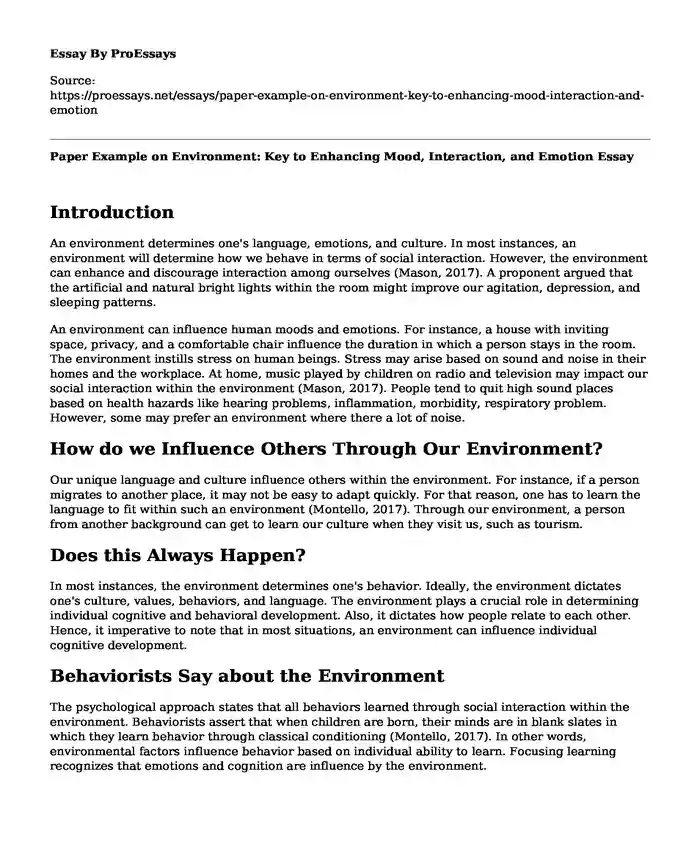Introduction
An environment determines one's language, emotions, and culture. In most instances, an environment will determine how we behave in terms of social interaction. However, the environment can enhance and discourage interaction among ourselves (Mason, 2017). A proponent argued that the artificial and natural bright lights within the room might improve our agitation, depression, and sleeping patterns.
An environment can influence human moods and emotions. For instance, a house with inviting space, privacy, and a comfortable chair influence the duration in which a person stays in the room. The environment instills stress on human beings. Stress may arise based on sound and noise in their homes and the workplace. At home, music played by children on radio and television may impact our social interaction within the environment (Mason, 2017). People tend to quit high sound places based on health hazards like hearing problems, inflammation, morbidity, respiratory problem. However, some may prefer an environment where there a lot of noise.
How do we Influence Others Through Our Environment?
Our unique language and culture influence others within the environment. For instance, if a person migrates to another place, it may not be easy to adapt quickly. For that reason, one has to learn the language to fit within such an environment (Montello, 2017). Through our environment, a person from another background can get to learn our culture when they visit us, such as tourism.
Does this Always Happen?
In most instances, the environment determines one's behavior. Ideally, the environment dictates one's culture, values, behaviors, and language. The environment plays a crucial role in determining individual cognitive and behavioral development. Also, it dictates how people relate to each other. Hence, it imperative to note that in most situations, an environment can influence individual cognitive development.
Behaviorists Say about the Environment
The psychological approach states that all behaviors learned through social interaction within the environment. Behaviorists assert that when children are born, their minds are in blank slates in which they learn behavior through classical conditioning (Montello, 2017). In other words, environmental factors influence behavior based on individual ability to learn. Focusing learning recognizes that emotions and cognition are influence by the environment.
The Reaction to the Theory
I agree with the theory. The psychological approach has considered the idea that all kinds of human behaviors learned through the interaction between people and the environment individual resides. I believe that the theory applies in more practical settings.
References
Mason, S. A. (2017). Behaviorist theory. Encyclopedia of Autism Spectrum Disorders, 1-3. https://doi.org/10.1007/978-1-4614-6435-8_143-3
Montello, D. R. (2017). Cognition and spatial behavior. International Encyclopedia of Geography: People, the Earth, Environment and Technology, 1-20. https://doi.org/10.1002/9781118786352.wbieg0498
Cite this page
Paper Example on Environment: Key to Enhancing Mood, Interaction, and Emotion. (2023, Sep 20). Retrieved from https://proessays.net/essays/paper-example-on-environment-key-to-enhancing-mood-interaction-and-emotion
If you are the original author of this essay and no longer wish to have it published on the ProEssays website, please click below to request its removal:
- High Nutritional Benefits of Breast Milk Essay
- Urban Bachata and Dominican Racial Identity in New York Essay
- The Motivation of Successful People Essay Example
- SLP Eval. & Manage. of Hyperkinetic Disorders Affecting Communication & Swallow - Essay Sample
- Essay Example on Overcoming Procrastination: The Keys to Academic Success
- Essay Example on Bipolar II Disorder: A Historical Look at its Development
- University Crisis Communication Plan: A Guide for Officials Paper







